Whether you’ve just dusted off the bicycle from the garage, bought a new bike from your local bike shop or found new inspiration at the gym or spin class this winter, you’re probably wondering how to prepare for that first bike rally. If you think you’re already prepared, think again. But not to worry! WheelBrothers has your thorough checklist right here.

Peach Pedal 2012, Author’s First Rally
_____Understand the Rules of the Road and Be Familiar with Group Ride Etiquette
The most efficient way to learn the rules of the road and understand group ride etiquette is to ride with a conscientious local shop ride or bike club. Many offer Beginners Rides and teach groups how to manage on bikes among one another and in traffic. This includes essential considerations, such as:
- Obeying all traffic laws, signs and stoplights
- Calling out debris and other dangers in the road
- Riding to the right so that faster bikes or traffic can pass on the left
- Calling out “on your left” as you pass slower bike traffic on their left
- Taking the lane when the group is turning
- Calling out left and right turns
- Calling out “slowing” or “stopping” when the group slows or stops
- Calling “car up” or “car back” (or “bikes up,” “walkers up,” etc.) when traffic is passing
- And more…
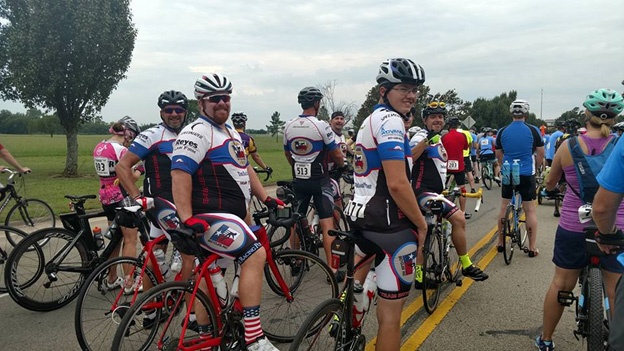
Tour de Paris 2017 Team Bicycles Inc
_____Study the Details of the Event, Route Options and Weather
As you begin to consider your Epic Ride options for 2019, head on over to https://www.wheelbrothers.com/texas-bike-rides/ to browse what’s available across the great state of Texas and beyond! Whether you want to stay close to home, make weekend trips around the state, or cross the border to pedal new roads, WheelBrothers has choices for all! Links are provided for event websites and registration, providing you with all the need-to-know details. Event pages will describe route options, what sort of bling you receive for participating, terrain (hilly, more hilly and off-the-strava-charts climbs), things to do in town, other simultaneous events, places to stay, who the event benefits, pictures from past events, reviews and more.
In Texas and anywhere else, weather is always a factor, so be sure you understand whether or not there is a rain forecasted for the event and whether there’s a return policy or not (many items purchased for an event like this cannot be returned, so flexibility is required here). Watch the weather so you know what to expect for event day. Some events, like Tour de Gruene, allow you to sign up for text updates—very handy, so if it’s offered take them up!
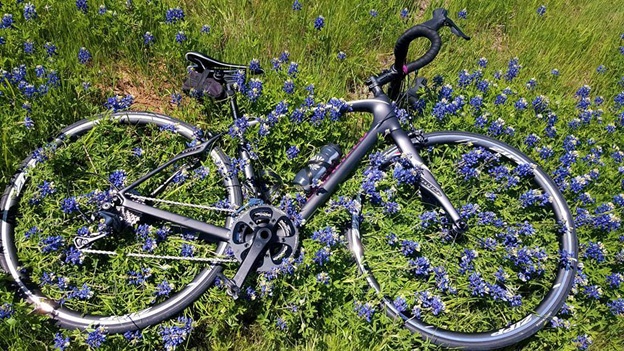
2016 Specialized Ruby Comp in Spring
_____ Make Sure Your Bike Fits and Has Had a Solid Check Over
Nothing is worse than planning for a memorable day on the bike only to have something go wrong that could have been prevented. For starters, your bike should fit you. If you haven’t ever had a fit, give your local bike shop a call to see what is costs. If you are not comfortable on your bike, you will not want to pedal very far. Pro tips: When in your saddle, there should be a slight bend in your knee when your pedal is at 6 o’clock. Your arms and back should form a 90’ angle for your reach, too.
Your local bike shop mechanic can check your bike over to be sure it’s in working order for your next ride. They will check details from front to back and top to bottom, including tire condition, chain condition, brakes, frame, etc. They will make you aware of anything needing attention, too, and you can prioritize from there.
_____ Obtain the Proper Equipment
Most, if not all rally organizers require that participants wear helmets. You should have a source of water (bottle cage and water bottle or Camelbak) and a source of electrolytes if you’re going longer distances or if it’s extra humid or hot. Your bike should be equipped with a seat pack complete with 1-2 tire tubes in case of a flat, CO2 or a small pump, and simple tools, including levers to change a flat. It is okay if you do not know how to change a flat (someone will help you—you’ll notice that we all take care of each other on the road AND that there’s SAG help, or vehicles going by to assist those in need), but it is good manners to have your own equipment. (By the way, it is not that hard to change a flat—I encourage you to learn!) Your local bike shop can also help you choose proper gloves to help you avoid numbing in the hands plus proper shorts and chamois cream to help you avoid discomfort and chaffing “down under.” Shorts and creams are best chosen well before event day while you are still training so you can be sure of tried-and-true gear with no surprises. Many cyclists wear a bracelet called a Road ID or something similar, which alerts first responders in case of emergency whether you have a medical condition or allergies and also lists numbers for whom to call if you have an accident. Most cyclists do carry their phone with them; some download the event route in addition to the route markers provided at the event.
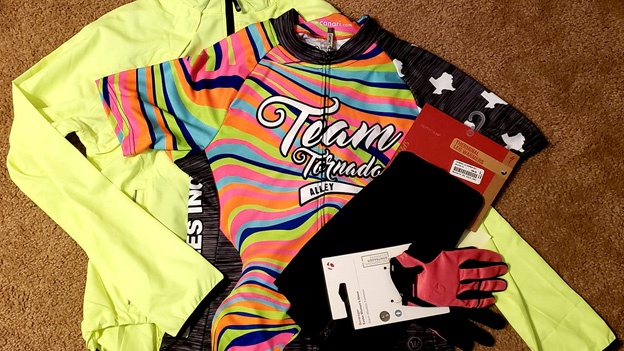
2018 Team Tornado Alley Jersey and Winter Gear
_____ Pack Your Own Nutrition Options…Just in Case
Part of the fun of bicycle rallies are the rest stops provided every 10-12 miles on the route. You get to stretch your legs, chat a short bit with strangers, and grab a snack for fuel. While you likely won’t need to stop at every single rest stop provided, so it’s wise to pack a back-up source of energy gels or bars in case rest stops run low on the standard cookies and fruit or you happen to be between stops and really need a boost. A $5 or $10 bill stashed in a jersey pocket for grabbing a treat at a convenience store is another option. Having your own goodies on-hand gives you control of your day. And always refill your water and electrolytes when you stop. Again, an event is not a place to try new nutrition options! Use the tried and true here for maximum happiness.

____ Layer for the Finish Line
The event start time and your estimated finish time may be forecasted to have very different temperatures. “Dress for the finish line” is the general rule, but you can layer with leg and arm warmers and a wind breaker which can be rolled up and slipped into your jersey pockets when you heat up on the road.
_____ Set Your Gear Out Days Before
Obviously, you’ll want to run through your checklist weeks in advance for training and shopping purposes. But when it’s time to pack up, you need to give yourself time for any last-minute oversights. It’s easy to think you are well-stocked in tubes or energy bars only to remember in the morning while loading that you gave your last tube to a friend or ate that last bar on the way to gym! As you plan for each event, you will get into a rhythm that helps you to remember everything from your helmet to your cleated shoes, to your water bottles and your completely charged phone. For example, I have certain bags for certain gear so I know at a glance whether it is properly packed or not.
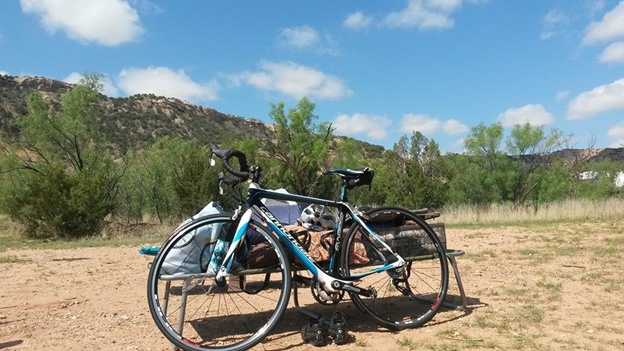
24 Hours in the Canyon 2014 “My Gypsy Life with MBBC”
_____ Get There Early
You have managed every single detail to this point, but there are some things that are out of your control. You may hit traffic or construction on the way to the event. It may take time to find parking or you may have to walk a long way to check in. It’s a far better feeling to get there an hour early, have the time to check in and gear up leisurely, avoiding the last-minute inevitable scramble for some. Sometimes the swag is limited, so getting there early also helps the chances of you getting your bling, plus getting bike-ready and on the start line without getting stressed out.

Lancaster Country Ride Registration 2016 and LCR Start Line 2013
_____ Enjoy Every Detail and Plan to Be Social
Every event has its own treats and surprises to offer, whether it be snow cones after the ride at Tour d’Italia, a hot air balloon glow in the evening after Tour de Paris or a visit to The Old Rock Church on the bike route at Tour de Norway. There may be exotic animals, fields of wildflowers, fantastic vistas, and other locations for an opportune selfie. Volunteers often take great pride in their rest stops, and you might see a different theme at each one… sometimes they even compete to be the best one, offering human bike valets, freshly baked cookies by local grandmothers and neck towels soaked in ice water on the hottest summer days! Don’t let yourself leave without taking in all that the event has to offer.
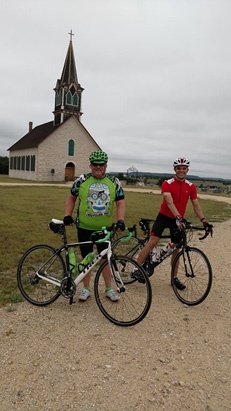
Tour de Norway 2017 The Old Rock Church
_____ Chronicle Your Adventures
Thanks to Facebook and my addiction to posting all-things-bicycle, I have a vast storage unit for resourcing pictures of rallies-past as shown in this article. Facebook, Instagram, or any public or private medium you choose are extremely helpful in recording your memories and tracking your growth and accomplishments. In addition, there are countless apps for tracking your miles like Strava—and many of those are free.
Every once in a while these can become great tools for yourself on an off day when things look less than ideal…it’s helpful to look back and see how far you’ve evolved in 5-7+ years, and exciting to know there is still so much to do!
_____ Say Thank You
I cannot begin to tell you how hard the organizers work to bring you a successful day on the bike. And 90% of that is carried out by volunteers! Once you get your bearings and 2-3 rally rides under your belt, please consider giving back as you are able. Words of thanks at every rest stop are always gratefully received. A kind review on an organizers page means so much. (If you have a valid concern message them privately and allow them time to address the issue.) Consider contributing to the charity that the ride supports. The best way to say thank you? Be a volunteer yourself! You will never see an event the same way again.
Lisa Tilley is a contributing writer for WheelBrothers, is a member of Fort Worth based MBBC, and is in sales at Bicycles Inc.
 Tour de Cypress Ride
Tour de Cypress Ride